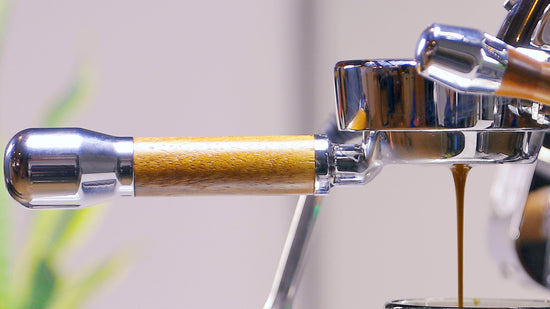Espresso Pucks: What Matters & What Doesn't

When pulling espresso a lot of attention gets put on the puck of ground coffee in the portafilter. Maybe it shouldn’t be a surprise since it’s the epicenter of the entire process. What can be difficult at times is discerning what matters and what doesn’t.
What’s Not Important
First we’ll look at what’s not important, starting with one of the most common questions posed by new baristas: why is the puck so soggy? For some reason, this is generally interpreted as a foreboding omen – a sign of some espresso sin that must be identified, rectified, and repented for. In reality, it probably doesn’t matter at all. We’ve had great shots from soggy pucks and terrible ones from beautiful pucks. The additional water could be there for one of a few reasons including, but not limited to, the volume of your dose compared to the size of the basket, the size of your grind, and even the roast of your coffee. At the end of the day, what matters is what’s in the cup – we left that water in the machine for a reason.
Next up: tamp pressure. As a barista, you’ll get all manner of conflicting advice about how much pressure to tamp with and why it matters. The results of our research match those of many of our peers – it really doesn’t matter that much. A harder tamp does very little - if anything - to slow down a shot. If your espresso doesn’t appear to be pulling to recipe, look at grind, dose, and coffee freshness before trying to press that puck through your counter.
Last in the unimportant category is the ridge on your basket. Many portafilter baskets have a small ridge visible on the inside which some intuit to be a sort of max-fill line or a dosing aid. In reality, the ridge simply helps the basket get a better grip from the spring in your portafilter, holding it in more snugly. When looking at picking up a precision basket like the VST, people often wonder what the difference between the ridged and ridgeless versions are and if they have any impact on extraction. The ridgeless basket simply lacks that ridge. Some prefer ridgeless because it’s easier to insert and remove from their portafilter. Others believe it might produce more even flow. We haven’t been able to discern a noticeable difference in results between ridged and ridgeless, so either way we’re sure you’ll get more consistent shots than with a standard basket.
What is Important
Now that we’ve identified all the dead ends let’s look at what does matter, starting with one of the most important steps in pulling a great shot: tamping and distribution. We’ve made a comprehensive video on this topic that I recommend watching if you haven’t already. To summarize, ensuring that your coffee is spread evenly across the surface of the basket while grinding and verifying that your tamp is nice and level will make a huge impact on extraction. Distribution tools and calibrated tampers can go a long way to making this simple and repeatable.
Next, make sure you’re using the proper dose for your basket. While you’ll often hear “single, double, and triple” many baskets – particularly nicer ones – have a designated dose weight. Generally, that’s 7 grams for a “single” basket, 18 grams for a “double” basket, and 20 grams for a “triple” basket. While we like to stick to 20- gram baskets there are many variations, with VST even making a 22- gram basket. The important thing is sticking to the proper dose. Straying by more than a gram can cause wildly inconsistent results.
Another important thing to look out for is channeling. Any sign of channeling is telling you something about what’s going on inside the puck during extraction. The surest way to spot it is by looking at the underside of your portafilter while your shot is pulling. Spraying, gaps in extraction, and the way the first drops come through the filter can all be warning signs. If you want to know more about channeling and how to spot it, we have a video on just that.
The last and certainly most important thing to pay attention to isn’t in the puck: it’s in your cup. It’s always good to remember that, at the end of the day, the taste of your espresso matters more than anything else. Not only because this whole craft is about enjoying a nice shot, but also because your tongue is a hyper-sensitive tool that can detect minute chemical differences. All these other details are simply steps on the way to taking a sip, trusting your tongue, and sitting down to enjoy some great coffee.